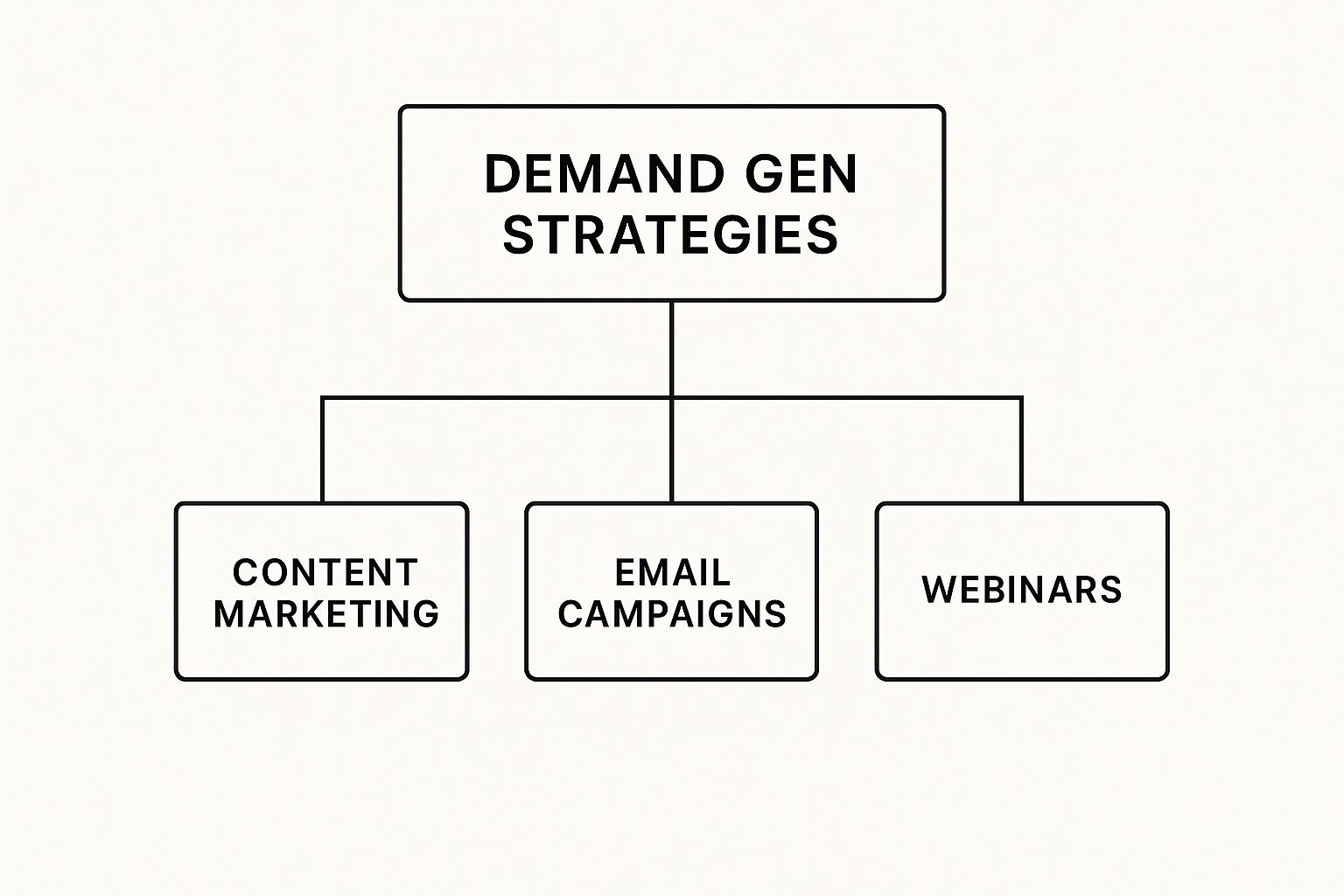A demand gen strategy is really just a long-term game plan to get people interested in what you do. It's all about creating awareness and educating your potential customers, building a foundation of trust long before they're even thinking about making a purchase. The goal is simple: when they finally have a need, your brand is the first one that comes to mind.
What a Demand Gen Strategy Actually Is

Let's ditch the textbook definition for a moment. Picture your demand gen strategy as the blueprint for an entire city. It's not just one building or a single road. It's the whole interconnected system—the highways, the power grid, the parks, and the schools—that makes people want to move in and stay for the long haul.
This is a world away from lead generation, which is more like putting up a single "For Sale" sign in that city. That sign might grab the attention of a few people driving by, but it’s the city's underlying infrastructure that creates a thriving, sustainable community.
Building a Foundation for Growth
A great demand generation strategy works by consistently educating your ideal customers. You establish your brand as the go-to expert in your field and build real relationships over time. The idea is to make your company’s name synonymous with the solution to their biggest problems.
This is about playing the long game. Instead of fighting over the tiny fraction of people ready to buy right this second, you're connecting with the entire market. That way, when the other 95% of potential buyers are finally ready to act, your brand is already their first and best choice.
This shift in focus brings some serious advantages:
- Creates a predictable pipeline: By consistently generating interest, you build a reliable flow of future business, not just a trickle of immediate leads.
- Builds brand authority: Sharing genuinely helpful, high-quality content cements your status as a trusted industry leader.
- Lowers customer acquisition costs (CAC): When prospects are already educated and trust your brand, the sales process becomes much smoother and more efficient.
Demand Gen vs Lead Gen
One of the biggest hang-ups people have is telling the difference between demand generation and lead generation. They're definitely related, but they have very different jobs. If you're fuzzy on the basics, getting clear on what are leads in business is a great place to start.
Demand generation is about creating the audience. It's the art of making people aware of a problem and positioning your brand as the expert. Lead generation is about converting that audience. It's the process of identifying specific individuals from that interested group who might become customers.
To make this crystal clear, let's break it down side-by-side.
Demand Generation vs Lead Generation At a Glance
| Aspect | Demand Generation | Lead Generation |
|---|---|---|
| Primary Goal | Create awareness and interest in your market. | Capture contact information from interested prospects. |
| Focus | Top of the funnel (educating the entire market). | Middle of the funnel (converting interest into leads). |
| Typical Tactics | Blog posts, podcasts, webinars, social media, SEO. | Gated content (eBooks, whitepapers), demo requests. |
| Key Metrics | Website traffic, social engagement, brand mentions. | Conversion rates, Cost Per Lead (CPL), lead quality. |
As you can see, one builds the pond, and the other goes fishing in it. You really can't have effective lead generation without a solid demand generation foundation in place first.
To really get a feel for how all the pieces fit together, it’s worth exploring the science of demand generation marketing to see how it operates as a full-blown revenue engine.
At the end of the day, a successful demand gen strategy isn't about chasing quick wins or vanity metrics. It’s a methodical, holistic way to grow your business by building genuine connections. When you create value before asking for a sale, you earn a loyal customer base that sees you not just as another vendor, but as an essential partner.
The Core Pillars of Modern Demand Generation
A solid demand gen strategy isn't just one tactic; it's a growth machine built on several interconnected parts. When these pieces work together smoothly, they create a powerful system that doesn't just attract potential customers—it turns them into genuine fans of your brand. Think of it like a championship sports team: every player has a specific role, but they only win by playing together.
To see how these strategies connect, the diagram below lays out a few common tactics branching from a central demand gen hub.

This visual makes it clear how activities like content marketing and webinars are foundational pieces of a much bigger, cohesive plan. Now, let's break down the four essential pillars that make this modern growth engine run.
Building Foundational Brand Awareness
The first pillar is all about becoming a familiar, trusted name in your space. This isn't the place for flashy "buy now" ads. Instead, the real work is in creating and sharing high-value, no-strings-attached content that actually helps your audience.
This approach positions your company as a helpful guide, not just another vendor.
- Podcasts: Get on the mic and host conversations with industry experts, sharing insights people can't find anywhere else.
- Original Research: Go deeper by publishing data-driven reports or surveys. This establishes you as a thought leader with unique knowledge.
- Community Building: Create a hub on LinkedIn or Slack where professionals can connect and learn, with your brand at the center of the conversation.
The goal here is simple: build authority and stay top-of-mind. When a potential customer finally hits a problem you solve, your brand is the first one they’ll think of.
Capturing Intent with Inbound Marketing
While brand awareness casts a wide net, our second pillar, inbound marketing, is designed to catch people who are actively looking for solutions. This is where you connect your expertise directly to what users are searching for through smart content and search engine optimization (SEO).
This pillar is what turns a passive observer into an active lead. By creating content that precisely answers the questions your ideal customers are typing into Google, you meet them right where they are, at the exact moment of need. A well-oiled inbound machine ensures your helpful articles, guides, and tools pop up first in search results, bringing qualified traffic right to your digital doorstep.
A powerful inbound marketing engine doesn't just bring in visitors; it brings in the right visitors. By aligning your content with high-intent keywords, you make sure the people finding you are already aware of their problem and actively seeking answers.
Precision Targeting with Account-Based Marketing
For businesses chasing high-value deals, the third pillar is Account-Based Marketing (ABM). If inbound marketing is like fishing with a net, ABM is like spear-fishing. It’s a hyper-focused approach that treats individual companies as a market of one.
Instead of broad-stroke campaigns, ABM is all about creating personalized experiences for a hand-picked list of target accounts. This might look like:
- Customized Content: Developing case studies or demos that speak directly to a specific company’s known pain points.
- Personalized Outreach: Crafting email sequences and ad campaigns that reference a target's industry, role, or recent company news.
- Coordinated Sales and Marketing Plays: Getting both teams on the same page to deliver a seamless, unified experience at every touchpoint.
This strategy is a game-changer for B2B companies with long sales cycles and large deal sizes, as it concentrates your resources where they’ll make the biggest splash. The evolution of demand gen has been massively shaped by tech, especially AI and ABM. Since the early 2000s, there's been a clear shift from a "more is more" quantity game to a smarter, quality-driven strategy. This was pushed forward by the move to digital-first marketing, which put a spotlight on getting marketing and sales teams aligned to drive real revenue. You can learn more about how technology is shaping the future of demand generation and full-funnel success.
Bridging the Gap with Sales Enablement
The final pillar, sales enablement, is the crucial bridge connecting all your hard marketing work to actual revenue. All the demand you've generated is for nothing if your sales team isn't equipped to turn that interest into closed deals.
Sales enablement is simply the process of giving your sales team everything they need to have better, more effective conversations with prospects. This includes:
- Timely Insights: Letting reps see a prospect's content journey and engagement history before they even pick up the phone.
- High-Impact Content: Arming them with battle cards, case studies, and ROI calculators made for specific buying situations.
- Consistent Training: Making sure the whole team is fluent in the messaging and value props you’ve established in your marketing.
In the end, these four pillars can't work in isolation. Brand awareness builds the audience, inbound marketing captures their attention, ABM zeros in on the best opportunities, and sales enablement turns those opportunities into paying customers. Together, they form a complete demand gen strategy that fuels sustainable, long-term growth.
How to Build Your Demand Gen Strategy Step by Step

Alright, you get the theory. Now, let’s get our hands dirty and actually build your demand gen strategy from the ground up. This isn't about throwing things at the wall to see what sticks. It's a thoughtful process of figuring out who you're talking to, meeting them where they are, and giving them something genuinely valuable.
Think of it as drawing a map for your future customers. Each step we take builds on the one before it, creating a single, cohesive system that moves people from vaguely aware to genuinely interested. We have to start with the most important piece of the puzzle: who are we even trying to reach?
Define Your Ideal Customer Profile
Before you write a single blog post or design one ad, you need an almost uncomfortably clear picture of your Ideal Customer Profile (ICP). This goes way beyond surface-level details like their job title or the size of their company. A truly useful ICP digs into the human being behind the title.
The goal is to know their world so well that you can practically finish their sentences.
- Pain Points: What’s the nagging problem that keeps them up at night? What are the biggest frustrations they deal with every day that you happen to solve?
- Buying Triggers: What specific event or change would make them suddenly start searching for a solution like yours? Maybe it’s a new boss, a blown budget, or just the final straw with their old, clunky system.
- Watering Holes: Where do they hang out online to learn and get advice? We're talking about specific podcasts, industry newsletters, LinkedIn personalities they follow, or niche Slack communities.
Getting this right is everything. It’s the critical foundation that stops you from burning cash trying to sell to people who will never, ever buy from you.
Map the Customer Journey
Once you know who you're after, you need to figure out how they make decisions. The path from "I have a problem" to "I'm buying this" is never a straight line. It’s a messy, winding road with lots of questions and second-guessing. Mapping this journey helps you pinpoint the exact moments where you can step in and be helpful.
Your job is to create a series of helpful signposts along their path. For every stage—from the first inkling of a problem to the final decision—you need to understand what’s going through their head and what questions they're asking themselves.
A well-mapped customer journey allows you to deliver the right content, to the right person, at exactly the right time. It transforms your marketing from random acts of content into a guided, helpful experience.
For example, someone in the early "awareness" stage doesn't want a demo. They're still just trying to wrap their head around the problem itself. A helpful blog post or an insightful podcast episode is what they need, not a sales pitch.
Create High-Value Content for Each Stage
Now that you have your ICP and their journey map, you can finally start creating content that actually hits the mark. A classic mistake is to create content that only speaks to people who are ready to buy right now. A real demand gen strategy needs to cover the entire journey, from top to bottom.
Here’s a simple way to think about it:
- Top of Funnel (Awareness): This is all about education, not your product. Think blog posts, podcasts, and original research that tackle your ICP’s biggest pain points head-on, without ever mentioning your brand.
- Middle of Funnel (Consideration): They know they have a problem and are starting to look at solutions. This is the perfect place for webinars, in-depth guides, and honest comparison articles that help them weigh their options.
- Bottom of Funnel (Decision): They're close to making a choice. Now's the time for case studies, customer stories, and detailed product walkthroughs that prove you’re the best choice to solve their specific problem.
The game has shifted from just capturing leads to creating a full-funnel experience that's built on trust and a deep understanding of the buyer. In fact, 57% of marketers now see case studies as a key tool for building credibility, showing just how important authentic storytelling has become. You can find more data on how experts are reshaping B2B demand generation for 2025.
Choose Your Distribution Channels
Making great content is only half the job. The other half is making sure the right people actually see it. Your distribution plan should come directly from that "watering holes" research you did for your ICP. You have to show up where your ideal customers are already spending their time.
Spreading your efforts across a few key channels is usually the smartest move.
- SEO: Getting your content to rank on Google means you'll consistently attract people who are actively searching for answers you provide. It's a long-term investment that pays for itself over and over.
- Social Media: Use platforms like LinkedIn not just to dump links, but to actually join conversations, share expert opinions, and build a community around your brand's point of view.
- Partner Marketing: Team up with other companies who serve the same audience but don't compete with you. You could co-host a webinar, write an ebook together, or simply promote each other's content to your respective email lists.
When you're strategic about your channels, your content doesn't just sit on your blog gathering digital dust. It gets out into the world and becomes a true engine for your company's growth.
Measuring What Truly Matters for Growth

It’s one thing to launch a brilliant demand gen strategy, but it’s another thing entirely to prove it’s actually working. The secret is to look past the "vanity metrics"—things like social media likes and page views—and focus on the numbers that tell the real story of your business growth.
These are the key performance indicators (KPIs) that connect your marketing spend directly to your bottom line. Think of them like the gauges on a car's dashboard. One gauge alone won’t tell you much, but together, they give you a complete picture of your engine's health and how fast you're heading toward your goal.
From Initial Interest to Sales-Ready
The first set of metrics you need to watch tracks a prospect's journey from just being curious to being genuinely committed. The handover point between your marketing and sales teams is where most strategies fall apart, so getting this right is non-negotiable. A clear definition here prevents friction and stops good leads from slipping through the cracks.
Marketing Qualified Leads (MQLs): An MQL is someone who’s shown enough interest to be considered a potential customer. Maybe they downloaded an ebook or joined a webinar. They're curious, but they aren’t quite ready for a sales call.
Sales Qualified Leads (SQLs): An SQL is an MQL who has been vetted by your team and is ready for a direct sales conversation. They’ve shown real intent, like requesting a demo or asking for pricing. This is the signal that they've shifted from "researching a problem" to "evaluating solutions."
Your MQL-to-SQL conversion rate is a critical health check for your entire demand gen engine. It tells you if all that awareness and interest you're building is actually turning into real sales opportunities. To get a better handle on tracking what’s working, check out our guide on how to measure marketing effectiveness.
Understanding the Economics of Growth
Once you’re tracking leads, you need to understand the financial side of things. Are you acquiring customers profitably? These next metrics reveal if your strategy is not just effective but also sustainable for the long haul.
Customer Acquisition Cost (CAC): This is simply the total amount you spend on sales and marketing to land a single new customer. A low CAC is a sign of an efficient strategy.
Customer Lifetime Value (CLV): This is the total revenue you can expect to earn from a single customer over the entire time they do business with you. A high CLV means you’re attracting and keeping the right kind of customers.
The magic number here is the CLV to CAC ratio. A healthy, sustainable business typically has a CLV that is at least three times its CAC. If your ratio is lower than that, you might be overspending to bring in customers who aren't a good fit.
Measuring Speed and Influence
Finally, let's look at a couple of more advanced concepts that give you a truly complete picture of your performance. They help you understand not just what is happening, but how quickly and why.
Pipeline Velocity: This metric calculates how fast leads are moving through your sales funnel and turning into actual revenue. It's a great way to measure the momentum and overall health of your sales cycle.
Multi-touch Attribution: This model gives credit to every touchpoint a customer interacts with on their path to purchase. It moves beyond the idea that only the first click or last click matters, giving you a holistic view of which channels are really driving your results.
Let’s talk numbers. The budget and revenue dynamics in this space are always shifting. Heading into 2025, 35% of marketers reported an increased budget, and 28% are projecting revenue growth between 11% and 20%. This growth is overwhelmingly tied to strategies that can prove their impact on business outcomes. For a deeper look at how data can shape your strategy, see what’s possible by leveraging data science in marketing.
Winning Demand Gen Strategies in Action
It's one thing to talk about theory, but the real lightbulb moments happen when you see a powerful demand gen strategy working in the real world. Let's move past simple tactics and really break down the "why" behind the success of two B2B titans.
These companies didn't stumble into success. They played the long game with brilliant strategies that you can absolutely borrow from. Their stories give us a clear picture of what works.
HubSpot: The Inbound Ecosystem
HubSpot is the undisputed heavyweight champion of demand generation, and their whole strategy is built on one core idea: be relentlessly helpful. They’ve constructed an entire ecosystem of free tools and educational content that solves actual problems for their audience, turning their brand into an unstoppable inbound machine.
Here's how they do it:
- Free, Genuinely Useful Tools: Think about the HubSpot CRM, Website Grader, or their Email Signature Generator. These aren't just flimsy lead magnets; they're legitimate products that fix an immediate headache for a marketer or salesperson. This builds trust and brand familiarity way before anyone even thinks about buying.
- World-Class Educational Content: The HubSpot Blog and HubSpot Academy are legendary for a reason. They offer deep, expert-level training on pretty much everything in marketing, sales, and customer service—and it's all free. This move cemented their reputation as the authority in the space.
This approach is so effective because it pulls in a huge audience, teaches them something valuable, and keeps them engaged. By the time someone in their ecosystem is ready to open their wallet for a paid tool, HubSpot isn't just an option; it's the obvious, trusted choice.
Gong: The Category Creator
Gong took a completely different, yet equally brilliant, route. They didn't just join a market; they created a whole new one: Revenue Intelligence. Their masterstroke was using proprietary data from their own platform to publish unique, jaw-dropping insights that no one else had.
Their content wasn't just another "10 tips" blog post. It was groundbreaking analysis that literally changed how sales leaders approached their craft. They then shared these insights everywhere their audience lived, especially on LinkedIn.
Gong’s strategy wasn't about joining the conversation; it was about owning it. They used hard data to make themselves an indispensable voice in the industry, effectively making their product and the category one and the same.
By sharing super-specific, data-backed advice like "the optimal number of questions to ask on a discovery call," they built a cult following. Sales pros got immediate value, started performing better, and saw Gong as the source of their new-found skills. This created a powerful wave of demand from the ground up, with reps begging their managers to buy the platform.
Both HubSpot and Gong teach us the same powerful lesson: winning at demand generation is about giving away tremendous value first. When you become a trusted, indispensable resource, you build an audience that can't wait to do business with you.
For a closer look at more B2B and B2C examples, you can find extra inspiration from these powerful demand generation strategies that get real results.
Wrapping It Up: Your Path to Sustainable Growth
So, there you have it—a complete blueprint for building a modern demand gen strategy. Think of this not as a quick-fix campaign, but as a long-term investment in creating a genuine, lasting relationship with your market. We've walked through the core pillars, the step-by-step roadmap, and why measuring everything is non-negotiable.
The biggest takeaway? Start small, but think big. You don't need to do everything at once. Real, sustainable momentum is built by getting one thing right and then moving on to the next.
Where Should You Start?
The best place to begin is wherever you can make the biggest splash. That first deliberate step sets the tone for everything else.
- Nail Down Your Ideal Customer: Go way beyond basic demographics. What really keeps your best customers up at night? Dig into their pain points and the triggers that actually make them buy. Getting this right from the start saves a ton of wasted effort later on.
- Create One Killer Piece of Content: Forget about churning out ten mediocre blog posts. Instead, pour your energy into creating one truly exceptional asset. Maybe it’s a definitive industry guide, an original research report packed with fresh data, or a can't-miss webinar. This is how you plant your flag and establish authority from day one.
Ultimately, a great demand gen strategy isn't just about finding customers. It's about building a predictable engine that keeps bringing them to you. Focus on quality and consistency, and you'll create a system that works for you long after the initial push.
This mindset shifts your marketing from a series of one-off tactics into a powerful, cohesive growth machine. It’s all about creating real value, earning trust, and becoming the go-to resource in your space.
You now have the framework and the confidence to get started. Take that first focused step, measure what happens, and build on every win. You’re ready to build an engine for predictable, lasting business growth.
Common Questions About Demand Gen Strategy, Answered
Even with a solid plan, a few questions always pop up. Let's tackle some of the most common points of confusion when it comes to building a demand generation strategy that actually works.
What’s the Real Difference Between Demand Gen and Lead Gen?
Let's use an analogy. Think of demand generation as the art of making people hungry. You're creating mouth-watering content and sharing stories that make your audience realize, "Hey, I have a problem, and I'm really interested in solving it." You're building an appetite from scratch.
Lead generation, on the other hand, is when the waiter comes to the table and asks for the order. It's the moment you offer a specific asset—like an ebook or a webinar signup—to capture the contact information of someone who's already hungry and ready to look at the menu.
Simply put, demand gen creates the desire in the market. Lead gen converts interested individuals within that market.
How Long Until I Actually See Results?
This is a big one. A demand generation strategy is a long game, not a quick fix you can turn on and off. You might see some encouraging early signs like a bump in website traffic or more social media engagement within the first 3-6 months.
But the real payoff—the stuff that gets executives excited, like a predictable sales pipeline and a lower cost to acquire customers—often takes a good 12-18 months to truly take shape.
Patience is the name of the game here. The whole point is to build a sustainable growth engine. Like any powerful machine, it takes time to assemble all the parts and get them running in perfect sync. Rushing it just leads to a wobbly foundation that will collapse later.
I'm a Small Business with a Tiny Budget. Where Do I Even Start?
Good news: you don't need a huge war chest to get started with demand gen. For smaller businesses, the secret is to focus on a few high-impact activities that build momentum over time without costing a fortune.
Here's where I'd tell you to start:
- Become Obsessed with Your ICP: Nailing down your Ideal Customer Profile costs you nothing but time, and it's the most critical step you'll take. Talk to your best customers. Find out what really keeps them up at night.
- Create One or Two "Pillar" Pieces of Content: Forget trying to blog every day. Instead, write one or two incredibly helpful, in-depth articles that solve a major problem for your ICP. Think quality, not quantity.
- Go All-In on Organic SEO: Optimizing your website and content for search engines is the ultimate long-term play. It costs very little to get started but delivers incredible compounding returns in traffic and authority down the road.
By zeroing in on these core areas, you can lay a rock-solid foundation for your demand gen efforts without breaking the bank. This sets you up perfectly to make bigger investments as you start to grow.
Ready to build a content engine that drives your demand gen strategy? Copy Masters delivers 30 search-optimized articles every month to help you outrank the competition and create a predictable pipeline of leads and sales. See how our low-risk, high-impact service can transform your blog into a sustainable growth machine at https://copymasters.co.
- SaaS SEO Consulting for Predictable Growth - October 20, 2025
- What Is SEO Management Your Guide to Real Results - October 19, 2025
- A Guide to Quality Content for SEO That Ranks - October 18, 2025
